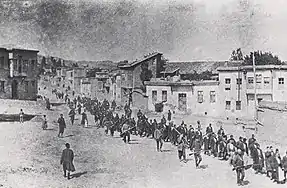Perpetrators, victims, and bystanders
In genocide studies, perpetrators, victims, and bystanders is a typology for classifying the participants and observers of a genocide, first proposed by Raul Hilberg in the 1992 book Perpetrators Victims Bystanders: Jewish Catastrophe 1933–1945.[2][3] Although considered a key element of scholarship on genocide,[4] the typology has also been criticized for vagueness and leading to overgeneralization. Jan Gross proposed that helpers and beneficiaries be added to the classification.[3] Robert Ehrenreich proposed that being a perpetrator, bystander, or victim is on a sliding scale rather than a discrete classification.[4] The triad is also used in studying the psychology of genocide.[5][6][7]

Ottoman soldiers (perpetrators) march Armenian civilians (victims) through Harput (Kharpert) to a prison in nearby Mezireh (Elazığ), April 1915, during the Armenian genocide.[1] Bystanders can also be seen in the photograph.

In this photograph showing the deportation of Jews from Kitzingen, Jewish victims are shown with local non-Jewish bystanders and policemen (perpetrators).
| Part of a series on |
| Genocide |
|---|
 |
| Issues |
| 18th and 19th century genocides |
| Early 20th century genocides |
| World War II (1939–1945) |
| Cold War (1940s–1991) |
| Contemporary genocides |
| Related topics |
|
| Category |
See also
References
- Sindelar, Daisy (23 April 2015). "1915: The Crumbling of an Empire, and the Massacre That Ensued". Radio Free Europe/Radio Liberty.
- Hilberg, Raul (1993). Perpetrators Victims Bystanders: Jewish Catastrophe 1933-1945. Harper Collins. ISBN 978-0-06-099507-2.
- "What is left of the Hilberg's triad "Perpetrators-Victims-Bystanders "? - Jewish Historical Institute". www.jhi.pl. Retrieved 19 July 2020.
- Ehrenreich, Robert M.; Cole, Tim (September 2005). "The Perpetrator-Bystander-Victim Constellation: Rethinking Genocidal Relationships". Human Organization. 64 (3): 213–224. doi:10.17730/humo.64.3.2y2n9ughb1wc7qq2.
- Vollhardt, Johanna Ray; Bilewicz, Michal (March 2013). "After the Genocide: Psychological Perspectives on Victim, Bystander, and Perpetrator Groups". Journal of Social Issues. 69 (1): 1–15. doi:10.1111/josi.12000.
- Staub, Ervin (June 1993). "The psychology of bystanders, perpetrators, and heroic helpers". International Journal of Intercultural Relations. 17 (3): 315–341. doi:10.1016/0147-1767(93)90037-9.
- Bar-On, Dan (1 June 2001). "The Bystander in Relation to the Victim and the Perpetrator: Today and During the Holocaust". Social Justice Research. 14 (2): 125–148. doi:10.1023/A:1012836918635. ISSN 1573-6725. S2CID 141171190.
Further reading
- Baum, Steven K. (2008). The Psychology of Genocide: Perpetrators, Bystanders, and Rescuers. Cambridge University Press. ISBN 978-0-521-71392-4.
- Horowitz, Sara R., ed. (2012). Back to the Sources: Reexamining Perpetrators, Victims, and Bystanders. Lessons and Legacies. Vol. X. Northwestern University Press. ISBN 978-0-8101-2862-0.
- King, Régine Uwibereyeho; Sakamoto, Izumi (August 2015). "Disengaging from genocide harm-doing and healing together between perpetrators, bystanders, and victims in Rwanda". Peace and Conflict: Journal of Peace Psychology. 21 (3): 378–394. doi:10.1037/pac0000078.
- Ionescu, Stefan (2011). "Perpetrators, Bystanders, and Rescuers. Popular Attitudes Towards Ottoman Christians During the Armenian Genocide". Studia Politica. Romanian Political Science Review. 11 (2): 328–344. ISSN 1582-4551. CEEOL 167447.
- Morina, Christina; Thijs, Krijn, eds. (2018). Probing the Limits of Categorization: The Bystander in Holocaust History. Berghahn Books. ISBN 978-1-78920-093-5.
- Robben, Antonius C.G.M. and Alexander Laban Hinton (2023). Perpetrators: Encountering Humanity’s Dark Side. Stanford: Stanford University Press. ISBN 978-1-503-63427-5.
This article is issued from Wikipedia. The text is licensed under Creative Commons - Attribution - Sharealike. Additional terms may apply for the media files.